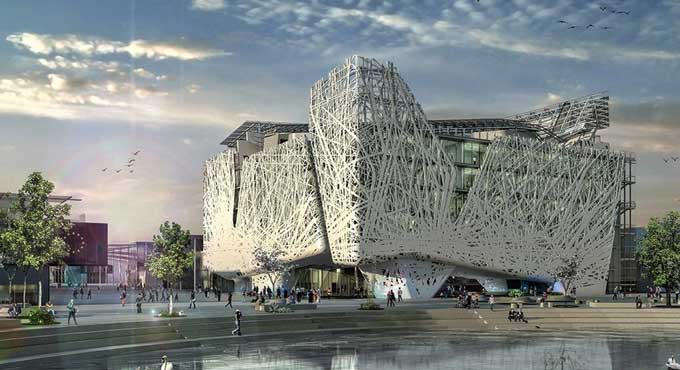
Why are Smog-Eating Buildings the Future of AEC?
In the recent age, pollution has emerged as the most problematic issue, particularly in urban areas. An increasing carbon footprint and environmental deterioration are the results of rapid urbanization, an increase in the number of building development and infrastructure projects, and excessive greenhouse gas emissions.
Climate change and global warming, both of which constitute a serious danger to humanity's existence, are being made worse by the increase in pollution. Moreover, it contributes to the loss of species and the lack of biodiversity.
So as a contribution to mankind, the modern AEC industries with the BIM infrastructure have introduced the Smog-eating structure to put some limit to the pollution around us. And that is what this article is all about, read the article to know more.
Smog-Eating Building
When a combination of pollutants, such as nitrogen oxides, volatile organic compounds, and particulate matter, interact with sunlight to create a haze in the atmosphere, it is called smog.
In recent years, architects and engineers from all over the world have developed the idea of "Smog-eating" buildings to address the current problem using ecologically friendly methods.
Smog-eating structures are built with the purpose of reducing air pollution in metropolitan areas by filtering out air contaminants. These structures are made of materials that have undergone photo catalytic treatment.
Pollutants are subsequently converted by the building surface into less harmful elements like carbon dioxide and water by the action of sunlight. Titanium dioxide is the most often employed coating substance in these structures.
Applied on the surface of materials like concrete, glass, and ceramic tiles, it is a white, powdered substance.
Benefits of Smog-Eating Buildings
The idea of smog-eating buildings is becoming increasingly popular in urban areas of the world. This type of building utilizes a special coating on the exterior walls that act as a filter to absorb and convert harmful pollutants into harmless compounds.
The benefits of smog-eating buildings are numerous and can have a significant impact on the air quality of an area. Here are some of the benefits of Smog-eating buildings:-
- First, smog-eating buildings can help reduce air pollution in cities. By absorbing and converting harmful pollutants, they can reduce the amount of smog in the air, resulting in better air quality.
- Additionally, smog-eating buildings can reduce the amount of particulate matter in the air, which is linked to various health problems. The reduction of these pollutants can result in significant improvements in air quality.
- Second, smog-eating buildings can help reduce global warming. The coating on the building's walls absorbs and converts carbon dioxide, one of the main contributors to global warming.
- By reducing the amount of carbon dioxide in the air, smog-eating buildings can help reduce the number of greenhouse gases that are released into the atmosphere. This in turn can help reduce global temperatures and mitigate the effects of climate change.
- Third, smog-eating buildings can help create a more aesthetically pleasing environment. The coating on the building's walls can improve the visual appeal of the city skyline, while also helping to reduce air pollution. This can make the area more attractive to potential visitors, which can help to boost the local economy.
- Finally, smog-eating buildings can help reduce energy costs. The special coating on the building's walls helps to insulate the building, which can reduce the amount of energy used for heating and cooling. As a result, building owners may be able to save a considerable amount of money.
Smog-eating buildings have numerous benefits, and they can reduce air pollution, help combat global warming, and create a more aesthetically pleasing environment. Additionally, they can also help reduce energy costs. For these reasons, smog-eating buildings are becoming increasingly popular in urban areas of the world.
Well-known Smog-eating Structures around the world
Below mentioned some of the well-known examples of Smog-eating Buildings around the world:-
The Palazzo Italia in Italy
The Palazzo Italia in Milan, Italy, was built for the 2015 World Expo and has titanium dioxide-containing cement all over it. The area's air quality can be improved by the cement's ability to degrade air contaminants.
According to estimates, Palazzo Italy will cut pollutants by up to more than 70%, significantly lessening the Expo's negative environmental effect. This structure serves as an example of how cutting-edge design may be applied to lessen the consequences of air pollution.
The Biblioteca Espana in Colombia
The Biblioteca Espana in Medellin, Colombia, has a titanium dioxide-based coating on its exterior. Pollutants in the air are broken down by the coating. The coating, which was created by a German business, can cut air pollution by up to 30%.
An illustration of how cutting-edge technology may be applied to counteract the deleterious impacts of air pollution is the Biblioteca.
The Torre de Especialidades in Mexico
Pollutants are subsequently converted by the building surface into less harmful elements like carbon dioxide and water by the action of sunlight. Titanium dioxide is the most often employed coating substance in these structures.
Applied on the surface of materials like concrete, glass, and ceramic tiles, it is a white, powdered substance.
To get more details, watch the following video tutorial.
Video Source: The B1M
Wrapping it up
The future of urban growth and environmental sustainability may be greatly impacted by the inclusion of smog-eating structures in urban design. Including smog-eating buildings might become the norm as cities get denser and air pollution becomes a bigger problem.


